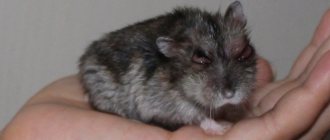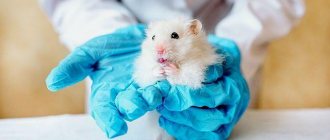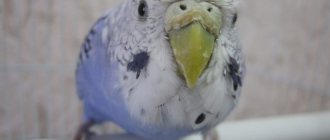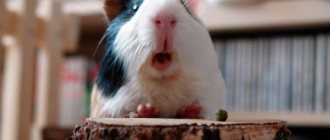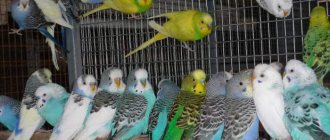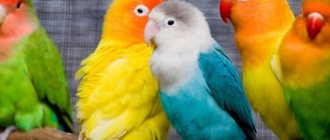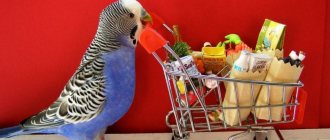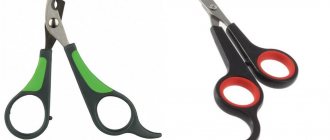The thought of why a parrot's feathers fall out occurs at least once in every poultry farmer. When a parrot loses its feathers, partially or completely, this is an alarming signal. If you do nothing, you may lose the bird. You will learn about the causes of feather loss and methods of help in this article.
Causes
The plumage of birds is one of the main indicators of their health. By the state of the plumage you can understand whether the feathered pet is healthy or not. In fact, feathers can fall out in wavy birds for a variety of reasons, ranging from ordinary molting to systemic, functional malfunctions in the body.
Important! If the bottom of a budgie's cage is strewn with down and feathers, and the loss of plumage is not associated with seasonal molting, the pet is lethargic, eats poorly, reacts poorly to external stimuli, the surrounding world, sits directly on the perch, you should not ignore this. It is possible that the bird is sick and has caught some kind of infection.
Baldness of a parrot
If you are wondering why a parrot loses its feathers, possible reasons include:
- viral, infectious, parasitic diseases;
- infection with feather eaters, ticks, and other ectoparasites;
- hypo-, avitaminosis;
- metabolic disorder;
- hormonal imbalance;
- endocrine pathologies;
- invasive, fungal diseases;
- French, shock molt;
- colds;
- violation of the rules for keeping birds (dirty or cramped cages);
- unbalanced, poor quality diet.
If a budgerigar's feathers fall out, the bird may have experienced severe stress or nervous tension. Loss of plumage may be due to a poor ecological situation in the region or an indoor microclimate unsuitable for wavy birds.
Important! If the parrot's cage is located in a room where flickering fluorescent lamps are installed, this will inevitably lead to intense feather loss. Such lighting has an adverse effect on the health of wavy birds and provokes severe stress in the bird.
Do not forget that parrots lose feathers intensively during seasonal molting, which usually occurs in autumn and spring. Subject to all maintenance conditions, if the wavy pet is healthy and feels well, the plumage is replaced twice a year. On average, the duration of molting is 27–32 days.
Natural molting in a parrot
Juvenile molting, during which the initial replacement of plumage occurs, occurs in wavy birds at the age of 3–4 months from birth. Its duration is approximately 60 days.
A deficiency of protein in feed causes the so-called French molt, which is characterized by the loss of feathers on the wings, as well as the absence of a tail in young wavy birds. Due to the fallen feathers, the birds cannot fly normally and move only on the ground.
French molt in wavy cats
During shock molting, budgerigars literally lose their feathers in bunches due to stress, especially in the tail area. Severe fear, noise, and frequent stressful situations can cause complete baldness of a feathered pet. Therefore, if you bring a feathered friend into your home, in addition to optimal housing conditions, pay more attention to it, especially during the adaptation period. Protect the bird from stress and anxiety.
If a parrot feels abandoned and unwanted, out of boredom he begins to pluck his feathers, thus trying to attract the attention of his owners.
Very often, budgies' feathers fall out due to hormonal imbalance and dysfunction of the thyroid gland. Budgerigars are very sensitive to the presence of hormones in the body that are produced by the thyroid and pituitary glands, and most often hormonal imbalance develops in birds that suffer from loneliness or receive poor-quality food.
Metabolic disorders, deficiency of minerals, vitamins, essential amino acids, and digestive problems will lead to the appearance of “dirty”, depigmented feathers in a budgerigar.
Treating your favorite birds
What to do when a parrot loses its plumage a lot and turns into a pitiful naked carcass? Before deciding to have pet birds, the future owner needs to study the rules for keeping parrots and ensure they have a full-fledged existence. And at the first signs of illness, immediately contact a veterinarian.
Only an experienced doctor can prescribe adequate and competent treatment for parrots. The advice of experts, not the arrogance of the owner, helps to put the bird in order!
Rules for keeping parrots
The subtleties of caring for friendly and funny winged pets depend on the breed of the parrot, the size of the bird and the characteristics of its habitat in natural conditions. But there are a number of general principles, following which the owner will ensure a comfortable and healthy existence for the pet. Before buying a parrot, prepare for its arrival:
- Spacious cage. For active birds, the dimensions of the home should start from 40x25x30 cm (this is the minimum). The larger the bird, the larger the house will be - the bird needs to freely flutter around the house without touching the bars.
- Feeder, bath and drinking bowl. It is advisable to purchase a couple of containers for food - for soft and grain foods. The best material is porcelain or plastic. You will need a bath in hot weather - after each bath, change the water and clean the container.
- Chalk for birds, various sticks, sand. Choose different perches, preferably from hard wood species (birch, oak, maple). The best diameter is 1.5-2 cm. Chalk supplies the bird with calcium and helps to sharpen the beak. And the sand is poured into a tray - it is necessary for good digestion (sand can be poured into a separate feeder).
- Toys (noisy, ringing, be sure to buy a mirror). A mirror will be needed if the pet plans to live separately.
- The menu should include: grain mixture, branches of deciduous trees (linden, aspen, hazel, rowan). Vegetables, curd products, fruits, and chicken eggs. Herbs (parsley, dill, sorrel, lettuce, dandelion stems). In winter, pamper your pet with sprouted grain (give the sprouts in portions and immediately remove the leftovers).
Let's go get the parrot. When purchasing a future pet, carefully inspect the bird. A healthy bird, cheerful and curious, with clean plumage without a hint of a bald spot. The beak is smooth without defects. The eyes are not puffy, clear. A bird in good health does not cough or sneeze. It is better to purchase young chicks - they will quickly get used to new living conditions.
We place the cage. Install the pet's home away from drafts and heating devices, preferably at the level of the owner's head.
It is forbidden! Place the cage in the kitchen, install it on household appliances (computer, oven, TV, microwave, refrigerator).
The parrot's home should be well illuminated by the sun's rays, but do not overuse the light - cover part of the house with a cloth so that the parrot can hide. For birds, the optimal air temperature is +20-25⁰ C. When choosing a cage size, be guided by the breed of bird:
| Parrot species | Dwelling size | ||
| Height (cm) | Bottom (cm) | Taphole diameter (cm) | |
| Amadin, Zebra, Kakarik, Wavy | 30 | 20x20 | 7 |
| Lovebirds | 35 | 22x22 | 7 |
| Corella, Rosella | 40 | 30x35 | 9 |
| Ozherelovy, ringed breeds | 40 | 35x40 | 9 |
| Alexandrian, Amazon, Jaco, small Cockatoos | 65-95 | 45x45 | 12 |
| Large cockatoos, macaws | 125 | 95x95 | 22 |
Care. Provide your talkative pet with constant, clean, unboiled water. Change the water daily. Wash water bowls and feeders well every day, clean the cage daily. And do a general tidy up every month, and after global cleaning, treat the toys and home with chamomile infusion.
Twice a year the cage and accessories are treated with Neostomosan. After disinfection, surfaces are rinsed with chamomile decoction and thoroughly ventilated. During cleaning, the birds are placed in a separate room. Every day, let the birds fly freely around the room (make sure the windows are closed). If a parrot ends up outside in winter, it is doomed to die.
Prevention
It is easier to predict any illness than to treat it. The owner, in addition to regular care and care, should constantly inspect and monitor the playful bird. A sudden change in behavior, cough, apathy, heavy breathing, loss of appetite become a reason for an immediate visit to the doctor. Each owner should also have a first aid kit, consisting of:
- Potassium permanganate.
- Baking soda.
- Boric acid.
- Pharmaceutical chamomile.
- Activated carbon.
- Spare carrier cage.
- Hydrogen peroxide (3%).
- Pipettes and containers for solutions.
- A narrow adhesive plaster, cotton wool and a bandage.
- Sterilized vegetable oil.
- Sodium citrate (Stroud's solution).
- Anti-burn agents (ointments or aerosols).
- Curved nail scissors or nippers (for processing the beak).
- Solid wood chips according to the size of the legs and wings (in case of a fracture as a temporary measure).
Remember! Diagnosis of parrot diseases is complex and is carried out only by experienced specialists. Self-treatment can worsen the condition of your beloved pet and lead to its death. Therefore, in case of any manifestations of disease, put the parrot in a carrier and rush to the veterinarian.
Only a doctor will explain what to give the bird, how to treat it, what medications to use.
Before you go to see your doctor, write down the following information on a piece of paper. The doctor will definitely ask about this - this information helps to more accurately establish the cause of the bird’s illness:
- Pet's age.
- Where is he kept (aviary, cage).
- What illnesses has your pet already suffered?
- When did you notice the first signs of the disease?
- When and under what conditions was the parrot purchased?
- Did the bird participate in exhibitions? If yes, when and where.
- What is the parrot's diet (name of food, supplements, vitamins).
Parasitic, fungal, infectious diseases
Very often, budgies lose their feathers due to infection with external parasites. If a parrot's body is parasitized by mites, the bird experiences severe itching and anxiety. In addition to fallen feathers, scratches, sores, and wounds appear on the body. The skin is peeling. With severe infection, acute inflammation can develop in various structures of the dermis. Infection with down feather eaters and scabies mites leads to deterioration of the plumage and provokes severe feather loss.
Sign of tick infestation
You can understand that a parrot is infected with a tick after a visual inspection of the pet or by performing a simple test. Line the bottom of the cage with white paper or a light-colored cloth. If you see small dark dots, be sure that your parrot is infected with a mite.
Lack of vitamins
Vitamin deficiency is another cause of feather loss in a pet. A lack of vitamins can also affect the appearance of a parrot. With this disease, the intensity of growth of claws and feathers decreases, and the general condition of the bird worsens.
Most often, parrots that have an unbalanced diet suffer from vitamin deficiency. Your daily diet should include grains, fruits, vegetables, and herbs. It is also worth taking your pet to a veterinarian. The specialist will be able to prescribe a drug that contains all the vitamins the bird needs. You can purchase the medicine at a veterinary pharmacy.
Hormones
Hormones affect not only our lives, but also the life of a parrot no less.
As you know, there are a lot of hormones known, and they are produced by endocrine glands. We will be more interested in the pituitary gland and the thyroid gland (thyroid gland).
When the level of hormones drops towards deficiency or excess, this immediately affects the quality and growth of feathers.
If the problem is in the pituitary gland, then it is unlikely that anything can be done, since there is simply no treatment, but in the case of the thyroid gland, everything can be solved with simple treatment.
But don’t worry, problems with pituitary hormones are quite rare in practice, much less common than, for example, the disease that we will consider below.
First aid for a bird
Many owners of feathered pets, and especially beginners, are often lost and do not know what to do when they notice the first loss of feathers in their parrots. However, in this case, you should not be alarmed - it is recommended to make an appointment with a veterinarian as soon as possible, who can accurately determine the cause, as well as prescribe the correct treatment.
At home, when self-plucking, you first need to treat the tail with a bitter spray (for example, Beafar Spray) or a soda solution, which can discourage the desire to pull out feathers.
You can also use a special collar, which can temporarily protect feathers and skin from additional beak injuries. The drug “Aloe Vera” is well suited for treating the skin, which is an antiseptic and hemostatic agent, while simultaneously softening and moisturizing irritated skin.
In case of injuries, they should be treated with hydrogen peroxide or a solution of Eplan, Ditsinon, or Etamzilat. After the bleeding has been stopped, the wound needs additional disinfection - Betadine, Chlorhexidine, Miramistin are well suited for these purposes. At the same time, you should absolutely not use alcohol, iodine or brilliant green.
Did you know? Parrots can be right-handed or left-handed
—
In order to determine this, you just have to take a closer look at which paw the bird most often uses to take food or open the cage door.
Juvenile
This type of molting occurs only in chicks that are completely covered with soft down. After a few months, the fluff is replaced by a stronger and harder feather. The new plumage provides more protection and allows the bird to fly.
Cockatiels begin molting at the age of 4–6 months.
The exact time when a parrot begins to change its plumage depends on care and maintenance, as well as nutrition. But in any case, the first molt should begin before six months of age. If this does not happen, the bird is most likely sick.
Important! During the first moult, new plumage appears closer to the age of one year. Its completion indicates that the cockatiel can find a mate and have offspring.
Signs
- There is fluff in or under the cage. Since it is lightweight, you can see its traces throughout the room.
- After the down is renewed, the feather falls out, tubes appear, these are new feathers, which will then straighten out.
- Shedding, especially the first one, is considered stressful for a pet. Therefore, some birds even develop lethargy and decreased appetite.
- The parrot is disheveled.
- The pet begins to itch, this helps reduce discomfort and speed up the process.
- The parrot may become irritable, aggressive, and make little contact.
For some wavy cats, molting is easy, while for others it causes severe discomfort. Therefore, it is important to monitor the condition of your ward and, if necessary, contact a specialist.
Why does a bird have a tail?
The bird's tail is essentially a unique mechanism developed by nature itself. Its structure involves folding and unfolding, lifting up and down, as well as mobility from side to side.
Thus, this irreplaceable part of the bird’s body performs a number of functions, the main of which include:
- control during flight - in other words, this is a kind of steering wheel with the help of which birds perform various maneuvers;
- braking and balancing - the tail helps the bird not to tip back during landing;
- aerodynamics - thanks to the tail, the shape of the body allows you to optimally distribute the load during flight.
In addition, birds often use their tail as a third wing, which allows them to expend less energy on moving in the air.
Important! It is impossible not to take into account the fact that many males use the tail to attract females to mating games, and therefore this part of the body of birds is often an integral factor in the possibility of reproduction.
Diseases
In some cases, the parrot may suffer from various fungal infections or mites.
In this case, you can immediately notice an uneven loss of feathers, with the appearance of bare areas of skin. It is necessary to promptly carry out an external inspection.
On bare areas of skin you may notice peeling and shallow wounds.
Fallen feathers will also quickly give themselves away - they will be literally pierced with small holes that will strongly resemble passages.
Well, if you find blood on them, then the situation will be almost completely clear.
In this situation, we can recommend you only one thing - contacting a veterinarian.
He will be able to quickly identify the problem and prescribe special ointments that will ease the bird’s suffering and rid it of parasites.
The course of treatment can be long, but it must be completed and even extended a little to avoid relapse.
